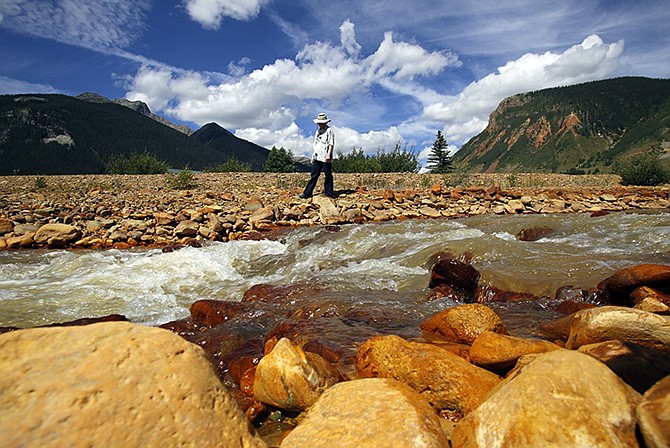SILVERTON, Colorado (AP) - The U.S. Environmental Protection Agency announced Thursday that surface-water testing revealed very high levels of lead, arsenic, cadmium and other heavy metals as a sickly-yellow plume of mine waste flowed through Colorado.
These metals far exceeded government exposure limits for aquatic life and humans in the hours after the Aug. 5 spill, which sent 3 million gallons of wastewater through three Western states and the Navajo nation.
The EPA, which released the results after 2 a.m. Eastern time under increasing political pressure, said its analysis shows the heavy metals quickly returned to "pre-event levels" once the plume passed through the area it tested, on the Animas River between Silverton, Colorado, and the downstream municipal water intake for Durango.
The abandoned Gold King mine had been slowly leaking a toxic stew for decades before an EPA crew accidentally unleashed a torrent of waste during an Aug. 5 inspection. EPA Administrator Gina McCarthy has taken full responsibility and promised the agency will pay for any damage.
The agency tested for 24 metals at the river's surface. One of the most dangerous, lead, was found below the 14th Street bridge in Silverton at more than 200 times higher than the acute exposure limit for aquatic life, and 3,580 times higher than federal standards for human drinking water.
Levels of arsenic were more than 24 times the exposure limit for fish and 823 times the level for human ingestion. Cadmium was found at more than six times the aquatic limit, 33 times that for humans.
The 100-mile-long plume has since dissipated, its heavy metals settling into riverbeds, during the waste's 300-mile journey toward Lake Powell, where the flow joins the Colorado River that supplies water to the Southwest.
McCarthy said Thursday these results show the river is "restoring itself."
She spoke during a visit to Farmington, New Mexico, where she announced the EPA has released $500,000 to help supply clean water for crop irrigation and livestock in northwestern New Mexico.
McCarthy acknowledged the concerns of state, local and tribal officials about the heavy metals now trapped in the river bed and along the banks, and promised to deal with the sediment problem over the long term, but offered no specifics.
Outside experts are warning of the potential for continued risk to both wildlife and humans for many years to come as the toxic metals settle into river bottoms and seep into groundwater.
"Heavy rains or flash floods could release any lingering contaminated sediments now trapped in the Animas River bed," said Marco Kaltofen, a Boston-based civil engineer who specializes in water pollution.
Over the long term, these metals can seep into the surrounding water table, potentially polluting drinking wells. The EPA has offered free water testing for homeowners with wells close to the river, but it's unclear how long that offer stands.
Attorneys general from Colorado, New Mexico and Utah vowed to ensure citizens and towns are compensated, even if the full impact isn't understood for many years.
"We have to be vigilant as attorneys general, as the lawyers for the state, as protectors of the environment, to be sure that the assurances that we received today from the Environmental Protection Agency are the same in two years, in five years, even 10 years when we discover what the damage to the environment actually is," said Colorado's attorney general, Cynthia Coffman.
Gold King is one of a cluster of old mines sending pollution downhill from tunnels dug 11,000 feet high in Colorado's San Juan Mountains. The spill made its impact far greater and more evident, disrupting thousands of lives and livelihoods.
Heavy metals occur naturally in the Rocky Mountains; they get released when water enters mines, either through mining operations or from snow and rain. Chemical reactions create sulfuric acid that dissolves heavy metals into the water, creating a toxic mess.
The spill happened as an EPA-supervised crew inspected a horizontal passageway into the partially collapsed and Gold King mine, which was abandoned in 1923. The workers dislodged some material, turning the steady flow of contaminated water into a torrent.

